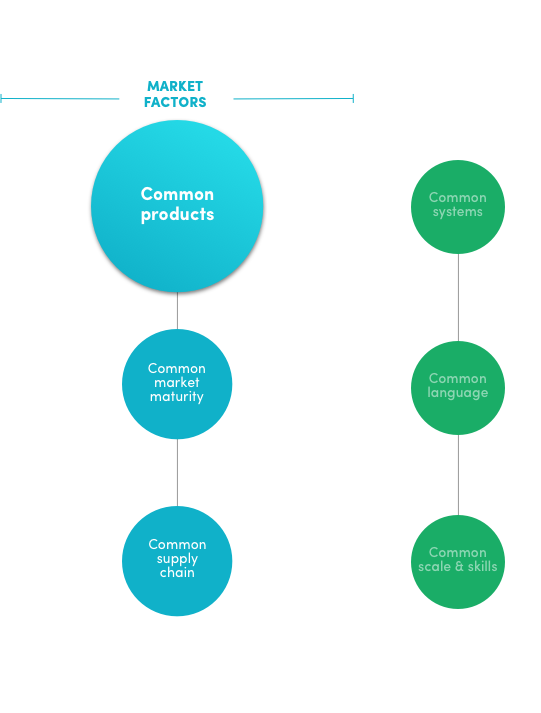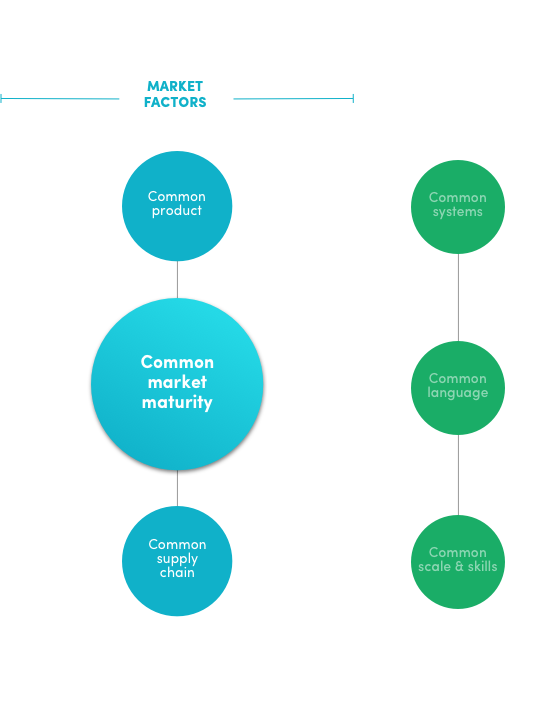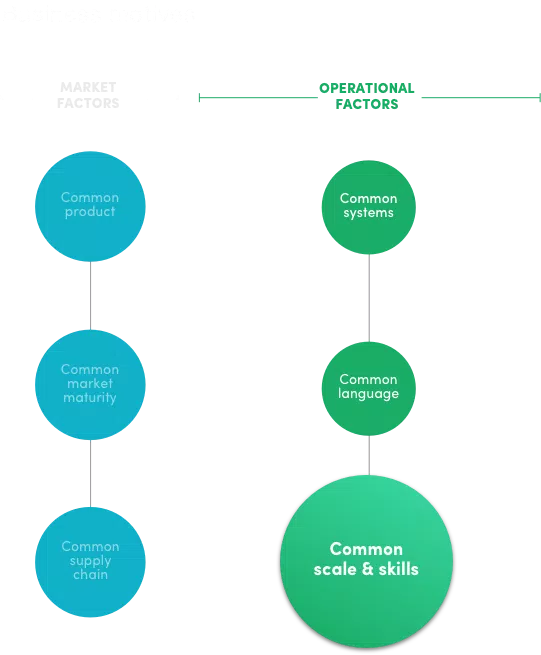If you want to go fast, go alone; if you want to go far, go together.
Go fast or go far? The implications of these different paths are a perennial dilemma for any leader within a multi-national or divisional organisation. Speed versus strength, agility versus security, cost versus revenue – all are considerations when looking to leverage an entity’s position. Within procurement, it’s no different.
That’s just the theory. Delivery itself overlays a wide range of further complications – from technical to organisational – and, for more than 20 years, Efficio has partnered with clients to solve them.
We hope that our experiences implementing change across borders, languages and cultures can help your procurement organisation thrive across borders in 2020 and beyond.
ALONE OR TOGETHER – ORGANISATIONAL MOTIVES
There are reasons that some businesses may wish to operate at organisational extremes of decentralisation or centralisation. Two key parameters concern the importance of control and leverage.
However, most organisations aim to lie in the wide continuum that sits between these extremes: for example, a centre-led or global-local approach.
Leaders tend towards a goal that mixes elements of all these factors – effectively, the desire to make an organisation more than the sum of its parts. This ‘cherry-pick’ ambition has large potential rewards, but it also makes the process complex and fraught with pitfalls.
OBJECTIVE REFLECTION – AGREEING THE RIGHT PROCUREMENT STRATEGY
Once organisational motives are clear, agreeing the right procurement strategy and operating model depends on a mixture of operational and market factors.
Consider the following parameters to gain a thorough view of your organisation’s target procurement model.
MARKET FACTORS
- Common product – Are you selling or providing the same goods and services across regions or is there a high degree of differentiation? This will dictate the likely extent that spend can be leveraged back through a common supply chain.
- Common market maturity – Is the market equally sophisticated and uniform in its requirements and dynamics? Are you the new entrant with a need for agility and speed to market or is the market mature and dictated by scale and efficiency?
- Common supply chain – Are suppliers common across borders and motivated to work as one entity? Too often global organisations will have a common product or service but find that the supply market is local, or when multi-national, they are often not organised or incentivised to work globally. All supply chains have a tipping point between scale and complexity. For some it’s at a local level, for others at a national level, but fully pan-European or global suppliers are less common.
OPERATIONAL FACTORS
- Common systems – Does your company’s operations have a way of sharing and aggregating granular data to drive insight? If not, what is the roadmap for system alignment? Without a common set of data and measures, leaders lose the ability to objectively challenge decisions and must rely more heavily on collaboration of regional leads.
- Common language – Are internal teams and suppliers able to converse and collaborate freely? Beyond the obvious language barrier, process effort scales with each new location and language. Additionally, the right skillsets may not be held by the people with the best language ability.
- Common scale and skills – Does your organisation have a uniform weight of resource and expertise across regions? A successful solution to pan-global success can be to foster centres of excellence where location is not a barrier to leadership. As teams become smaller, however, capacity and the risks of double or triple ‘hatting’ become worse.
- Common objectives – Are regions motivated to collaborate and do your financial performance metrics support recognition of the whole as well as the individual parts? Where P&Ls sit regionally or divisions are led by entrepreneur managers, leaders must be pragmatic about the extent and speed of change. If change is only led centrally, you initially remove self-serving behaviours but risk sowing longer-term ambivalence to the programme. If you secure commitment locally, the benefits case needs to be clear, equitable and secure quick wins.






CULTURE SHOCK – DELIVERING CHANGE ACROSS BORDERS
Once your strategy has been defined as a result of logical and pragmatic assessment, next comes the process of change – a more sensitive and nuanced activity.
Kotter’s 8-step change model is a well-regarded framework centred around communication, vision, coalition and culture. However, too often these elements are misunderstood or ignored in pursuit of quickly securing the benefits case within a change agenda. When working across borders, they become of paramount importance.
A nation’s culture resides in the hearts and souls of its people
Toby Munyard, VP at Efficio, suggests, “The pan-European projects that we see fail share the same hallmarks: they are centre-led, homogeneous and view country-level input as binary – either right or wrong.
Those that succeed find synergy between the strategy and the realities within each country; they are led by people who listen and relate. People who are consistently filter through the myriad of reasons not to change to find the pockets of excellence and the critical local content insight that really adds value.”
LANGUAGE COUNTS
International change programmes must be made up of multi-cultural teams – not just in terms of being able to operate with local languages, but also local culture and ways of working to anticipate misconceptions before they occur.
Julian Catchick, a Principal at Efficio, suggests, "Operating in a common language, but having members of a central team that are able to speak some of the local language – especially in regions that account for the bulk of a company’s spend – helps foster relationships, trust and a common goal with local procurement and business stakeholders."
We have observed notable differences in the ways of working and expectations from the perspective of each region.
CULTURAL DIFFERENCES IN LEADERSHIP
On leadership styles, Jose Oliveira, Efficio VP for the Americas says, "The U.S. structure tends to be less hierarchical and more business case. You have to craft a good narrative about why your proposition is logical. The way you communicate is sometimes more important than the substance."
Whereas Philippe Salavert, a French national who is now a Principal in Efficio Nordics tells us, "In France, people don’t hesitate to challenge you; they often ask for detailed rationalisation and discussion to be convinced for the need to drive change. In Scandinavia, you can’t really push too hard for change. Working with them requires a more collaborative, inclusive approach."
MANAGEMENT AND EXPECTATION
What practical steps need to be taken? Some common pan-global themes become apparent. There are no silver bullets, but there are some well-trodden best practices that, balanced with the right expectation setting, deliver results.
Launch control: Conducting a programme launch upfront is essential. If budgets allow, launch locally – not just at Group level – to avoid the perception of the activity being led by the centre for the good of the centre. Set a vision, agree a plan and ways of working, acknowledge and record concerns and constraints. Review this process at mid-programme and at its conclusion.
Share the love: The winner should be the business as a whole. Everyone needs to buy into this as, from time to time, local sacrifices may need to be made for the common good. Set common incentives and agree common ways of working.
Communicate, communicate, communicate: Once started, keep up the communication, make it positive and deliver it in a timely manner. Quick wins are essential, as is personal and local team recognition.
Major TOM: Establish a clear Target Operating Model and governance structure that outlines the roles of different teams and individuals on a global, regional and local basis.
Mission control: Establish senior leadership sponsorship and representation to help drive change.
Patience: Be patient. This level of change doesn’t happen overnight and will take time. Whilst a challenging and tightly managed plan should be in place, the steps should not be rushed.
Pan Global Poll
Does your procurement organisation intent to act more as a group or global function in the future?
IT WASN’T RAINING WHEN NOAH BUILT THE ARK …
Organisations operate across borders; supply chains operate across borders; and so do procurement functions. This doesn’t mean a rush to centralise, but it does require a careful plan. Cross-border procurement collaboration presents a great opportunity for the organisation prepared to understand its business and its requirements, to then build a strategy that leverages its unique skills and position – all in a well-executed plan.
Successful leaders who carefully evaluate these questions and practices to structure their pan-global plan can increase their likelihood to realise reduced costs, greater agility, deeper control and insight and nurture thriving teams.
So, pack your passport and business cards, and start your journey. It’ll be worth it.
Printable PDF